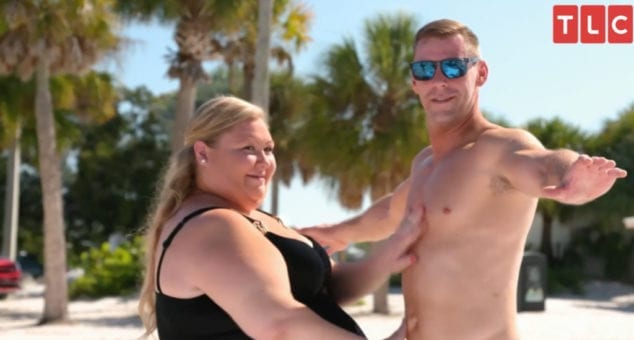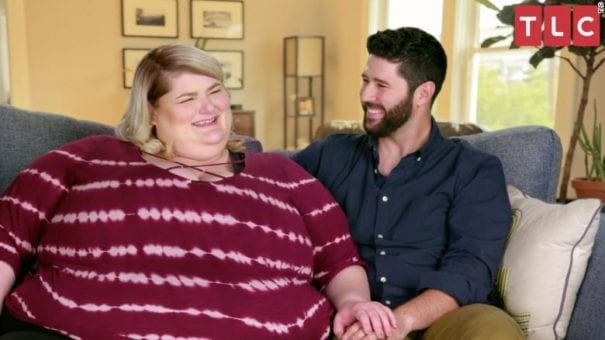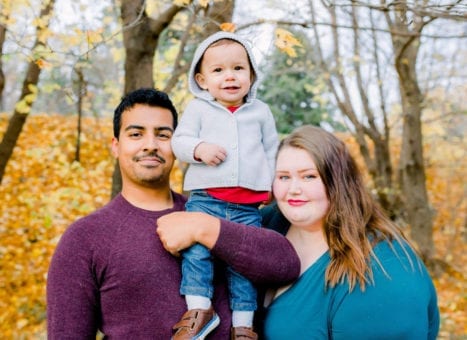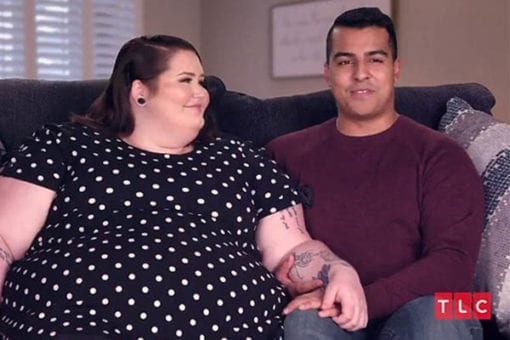TLC’s “Hot and Heavy” aims to take an honest look at “mixed weight” relationships. Do they get it right? The answer is, unfortunately, no.
Content warning for fatphobia, weight loss surgery, and fat-shaming
It may come as a surprise to its current audience, but cable channel TLC once belonged to NASA and the United States government. The Learning Channel was founded in 1972 with the mission to provide educational programming, using a NASA satellite to distribute their educational content for free. The channel was privatized in 1980, and The Learning Channel became TLC. It’s not entirely clear how the channel shifted from educational programming to, say, “Here Comes Honey Boo Boo,” but TLC’s bread and butter has become reality television. Their latest offering is a show called “Hot and Heavy,” which follows three “mixed-weight couples.”
The show received some intense early backlash when its trailer was released, but as a fat woman married to a thinner man, I was curious to see what direction this show took. The relationships, at least on the surface, looked a lot like mine. But after viewing the three episodes of “Hot and Heavy” that are currently available, I have to agree with the criticism of the show. Here’s what it gets wrong (and what it, perhaps accidentally, gets right.)
Of course, only the women are heavier.
Let's retitle, "How Can Men Possibly Love Fat Women?"
🙄🙄🙄— Emily McCarty (@emjmccarty) December 11, 2019
What TLC’s Hot and Heavy is About
“Hot and Heavy” follows three couples with a very particular dynamic: they are in heterosexual, monogamous relationships where there is a weight disparity between the couples. In each relationship, the woman is fat and the man is thin or has a medium build. The title seems to be referencing the two parties in the relationship: the men are “hot” and the women are, of course, “heavy.” (The title, in particular, was a huge cause of the early backlash — the implication being that the fat partner is not “hot.”)

Kristin and Rusty on the beach
Joy and Chris are engaged, but Chris’ mother and friends are concerned that Joy won’t be able to “keep up” with his active lifestyle. Kristin and Rusty want to have children, but Kristin believes (and has doctors and family members telling her) that she must lose weight in order to conceive. In direct contrast to Kristin, Adrianna and Ricardo got pregnant within weeks of getting together, and are raising a child together. (The conflicting narratives about pregnancy and weight are left unaddressed by “Hot and Heavy.”)
There have only been three episodes released at this point, and it’s unclear whether there will be more.
The Problem with the Premise of “Hot and Heavy”
“Hot and Heavy” may aim to shed light on romantic relationships outside of the “norm” for viewers, but it can only do that by building the foundation of the show on assumptions about what constitutes a “normal” relationship.
Despite the weight difference, the couples on “Hot and Heavy” are very much conventional. They’re heterosexual. They’re monogamous. And with the exception of Ricardo, all of the cast members are white. They seem to be relatively affluent. Kristin is actually independently wealthy due to the sale of a successful bridal business. Joy and Chris had enough money between them to maintain a long-distance relationship that required many plane rides. (At one point, Joy jokes about their “expensive courtship,” saying they’ve spent over $15,000 on plane tickets.) Beyond their weight difference, the couples don’t seem to have many problems. They’re doing well. Without them reinforcing every other standard of what constitutes a “normal” relationship, the premise would fall apart, because “Hot and Heavy” demands that their primary struggle be the woman’s weight.
Standard-Issue Fatphobia
TLC’s “Hot and Heavy” presents the weight difference as not just a burden, but a shared burden. Only that’s not entirely true. What is true is that we see the women on the show subjected to some truly awful behavior from people around them.
Chris’ mother (who had weight loss surgery just 4 months before the show was filmed) harps on Joy’s weight incessantly. In one scene, she expresses her disappointment and doubts to Joy’s friend at a wedding dress fitting, which Joy was gracious enough to invite her to attend. In another scene, she takes her concern trolling to Chris, reminding him of his dream of backpacking through Europe and that his marriage to Joy may hold him back from his dreams. On Joy and Chris’ wedding day, she makes Joy cry and puts her in the position of justifying their relationship. She finally gives Chris her reluctant blessing after cornering him about her “concerns” one last time.

Joy and Chris on “Hot and Heavy”
Adrianna confronts a man who bullied her for her weight in high school, damaging her confidence and resulting in binge eating for comfort. During the confrontation, we learn that they were romantically involved, and he seemed to start bullying her to distance himself from their brief tryst. As a result, she has difficulty trusting men who show an interest in her. “People wonder why Ricardo is with somebody like me,” she says to the camera. In one scene, Adrianna and Ricardo enjoy ice cream together on the street, and a man drives past in a car calling Adrianna a “cow” and actually mooing at her. The confrontation brings her to tears.
Kristin’s family pressures her about getting weight-loss surgery, with one family member (who has already had weight loss surgery and notes that her stomach is now “the size of an egg”) telling her if she wants to get pregnant, she needs to “get the surgery.” Her doctor also affirms that if she would like to be a mother, she must first lose weight. Her family and doctor present her choices as a severe dichotomy: have surgery and finally have a family, or die young. There is no in-between for Kristin, it seems.
But the thing that’s clear is that this treatment is not a shared burden: it’s fatphobia. The fat women on the show are treated horribly, but the men are often passive bystanders. During one of the many conversations with Chris’ mother, he agrees that Joy’s weight is “the elephant in the room.” (Yikes.) Chris’ friends say their “jaws dropped” when they met Joy. One of his friends exclaiming to the camera, “That’s what you really want to be with?”, reducing Chris’ fiancé from a who to a that. Rusty is resistant to the idea of Kristin getting weight loss surgery, but his concern is not framed as being about her well-being or the very real risks involved in the surgery, but rather his fear that she will be less desirable to him if she loses weight. She receives heaps of bad advice, and is subjected to doctors trying to solve the issue of her weight rather than her fertility. (And no one tells her these two things are not necessarily connected, as Adrianna and her adorable child can attest.) Bluntly displaying the terrible treatment Joy, Adrianna, and Kristin are subjected to is one of the few things “Hot and Heavy” does right. It’s hard to watch. But this is regular old fatphobia. It has nothing to do with their romantic relationships, and it isn’t specific to “mixed-weight” relationships.
Do the men on “Hot and Heavy” get to claim that this hardship is also theirs? Do they get to say that they experience ridicule, oppression, and poor treatment when literally all of it is directed at their partners? I don’t think they do. The show tries to make the case that this is something the couples experience collectively, but that is clearly not the case. The doubt and disbelief that some of the people in these mens’ lives express about their relationships is aimed squarely at their partners; it exists within the framework of the “hot” medium-build men being more valuable and desirable than their fat partners because they have thinner bodies. The small amount of hardship they do face, in the form of people expressing concern and confusion about their choices, is because of fatphobia. It is absurd to see this as an experience the men and women on “Hot and Heavy” share evenly.
Dealing with Fatphobia in Relationships
Far from being the source of conflict and fatphobia, my own marriage is a safe haven from it. Have we experienced heads cocked in confusion from people we know? Maybe once or twice when we first got together. Occasionally, when my husband introduces me to someone through his job, I can hear the tires screeching in their heads when they meet me. It seems to catch them off guard, because most people expect someone thinner. But most people quickly get over it.
Fatphobia is a presence in our relationship, because it’s a presence in my life. I have a harder time accessing compassionate, competent medical care. Weight stigma from medical professionals has played a role in our decision not to have children, though it’s not the only factor. In many ways, I benefit from his privilege. I can bring him to medical appointments and be taken more seriously. He can advocate for me by doing things like making sure that places we go have accessible seating, and communicating that message to people we might be going out with so I don’t have to be the one to do it. My husband is my fiercest ally. But it is not an everyday struggle, nor is my weight at the center of our relationship with each other.
And it’s worth mentioning that couples where both parties are fat, or perhaps live in the intersection of multiple marginalized identities (such as being LGBTQIA+, trans, non-binary, disabled, or subject to racial discrimination, etc.), face many more significant challenges than I will ever face as the fat wife of thin white guy.
The Problem with the Production of “Hot and Heavy”
While it’s hardly surprising, given that TLC is the same network that produces “My 600-lb Life,” the producers on “Hot and Heavy” go all in to make sure the women on the show look as large and “unhealthy” as possible. The women are frequently shot from an odd upward angle, to emphasize their enormity. We are often treated to isolated audio of their breathing, to drive home the point that it is labored. Joy is subjected to amplified audio of her breathing as she walks down a set of stairs to meet Chris at the altar on her wedding day, a disrespectful aside in an otherwise very lovely scene. Adrianna tackles a very steep hike with Ricardo and a group of her high school friends, where her difficulty breathing is emphasized by the production. (Adrianna completed the hike, just as her group of thinner friends did without having their breathing isolated by production.) In the very first episode, Joy and a few of her friends (who are also higher-weight women) climb into a hot tub and send a comically huge wave of water out of the hot tub. (Gotta love water displacement jokes, right?!) All three couples’ interview segments are filmed on a love seat that squishes the couples together — when it’s not uncommon among other reality television shows on TLC for couples to get a full-sized sofa, or even separate chairs.

Ricardo, Adrianna and their son
“Hot and Heavy” also toys with fetishism, as is often the case with portrayals of relationships with fat women. At the beginning of the first episode, Chris discusses that he enjoys having Joy’s weight on him, a practice known as “squashing.” It is heavily implied that Rusty is what’s known as a “feeder,” which is a person who fantasizes about seeing their partner gain weight, and that he is distressed by the idea of Kristin no longer being sexually attractive to him if she were to lose weight. Adrianna and Ricardo fare a little bit better, but in the final episode, Adrianna gifts Ricardo a boudoir shot of herself… sensually posing with a piece of cake. One of the clips we see in the trailer and in the first episode is Chris saying, “I love every inch of Joy. And there are a lot of inches to love.” Joy giggles and said, “Ew.”
This is a common issue with the representation of romantic relationships involving fat people in the media. It can be hard to find any representation of fat people as just… people. Whatever goes on behind closed doors between consenting adults is not the issue. It’s the fact that love involving a fat person is so often viewed through a fetishizing lens. It can feel dehumanizing to see attraction to fat people (which is common) be minimized to merely a fetish. Because some people are so confounded by attraction to fat people, and women with fat bodies are considered so low value in society, it must be a fetish, something taboo and unusual. This is something we see almost exclusively with “mixed-weight” relationships like the ones in “Hot and Heavy.” Relationships between thin or medium-build people never have this spin on them, nor do relationships between two fat people. And it was certainly never implied that, say, Carmella Soprano was a feeder just because she happened to be married to a fat man on “The Sopranos.” This fetishization is reserved for fat women because of the way society devalues us.
There is always nervous excitement when a show is announced that might provide some degree of fat representation. Fat communities have thrown their support behind work like AMC’s “Dietland,” Netflix’s “Dumplin’,” Hulu’s “Shrill,” and has embraced TLC’s “My Big Fat Fabulous Life,” or at least its star, Whitney Way-Thore. Representation is so scarce for us that, even imperfect representations like Kate’s character on “This Is Us” get cheered on as small victories. Unfortunately, “Hot and Heavy” touches on some painful truths, but ultimately fails to fully examine them and misses the mark. “Hot and Heavy” provides yet another disappointment for an audience that is aching to be represented truthfully and positively.
